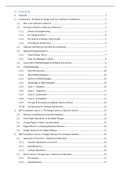Summary
Samenvatting Software architectuur
- Course
- Institution
- Book
Dit is mijn samenvatting van het vak Software architectuur, gegeven door professor Mannaert aan de Universiteit van Antwerpen. Mijn samenvatting bevat de geziene leerstof, de gegeven gastcolleges, de reflectie op het groepswerk en de gekregen examenvragen van 2021. Het is in het Engels geschreven, ...
[Show more]




